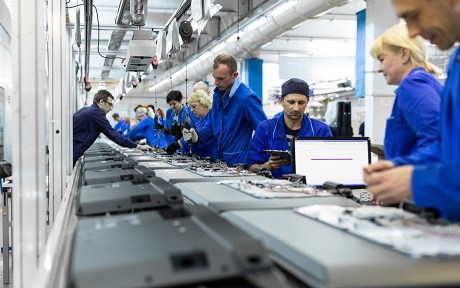
All through the 20th century, regular technological and organizational improvements, together with the buildup of productive capital, elevated labor productiveness at a gentle fee of round 2 p.c per 12 months. Nevertheless, the previous 20 years have witnessed a slowdown in labor productiveness, measured as worth added per hour labored. This slowdown has been notably stark within the manufacturing sector, which traditionally has been a number one sector in driving the productiveness of the combination U.S. economic system. What makes this slowdown notably puzzling is the truth that manufacturing accounts for almost all of U.S. analysis and improvement (R&D) expenditure. Regardless of a number of latest research (see, for instance, Syverson [2016]), a lot stays to be uncovered concerning the nature of this slowdown. This submit illustrates a key side of the thriller: the productiveness slowdown seems to be pervasive throughout industries and throughout corporations of varied sizes.
The Labor Productiveness Slowdown in U.S. Manufacturing
We begin with the chart beneath, which exhibits labor productiveness of the U.S. manufacturing sector from 1987 to 2022, primarily based on the industry-level knowledge from the Bureau of Labor Statistics (BLS). The index of labor productiveness within the U.S. manufacturing sector is outlined as the actual worth added of the {industry} per hour of labor, the place the {industry} is assessed on the NAICS three-digit degree. The chart exhibits the ensuing sequence each primarily based on the present share of every {industry} within the whole employment of the sector (stable blue line) and primarily based on these {industry} shares fastened to their 1987 values (dotted blue line).
Labor Productiveness Slows Down Starting within the Late 2000s
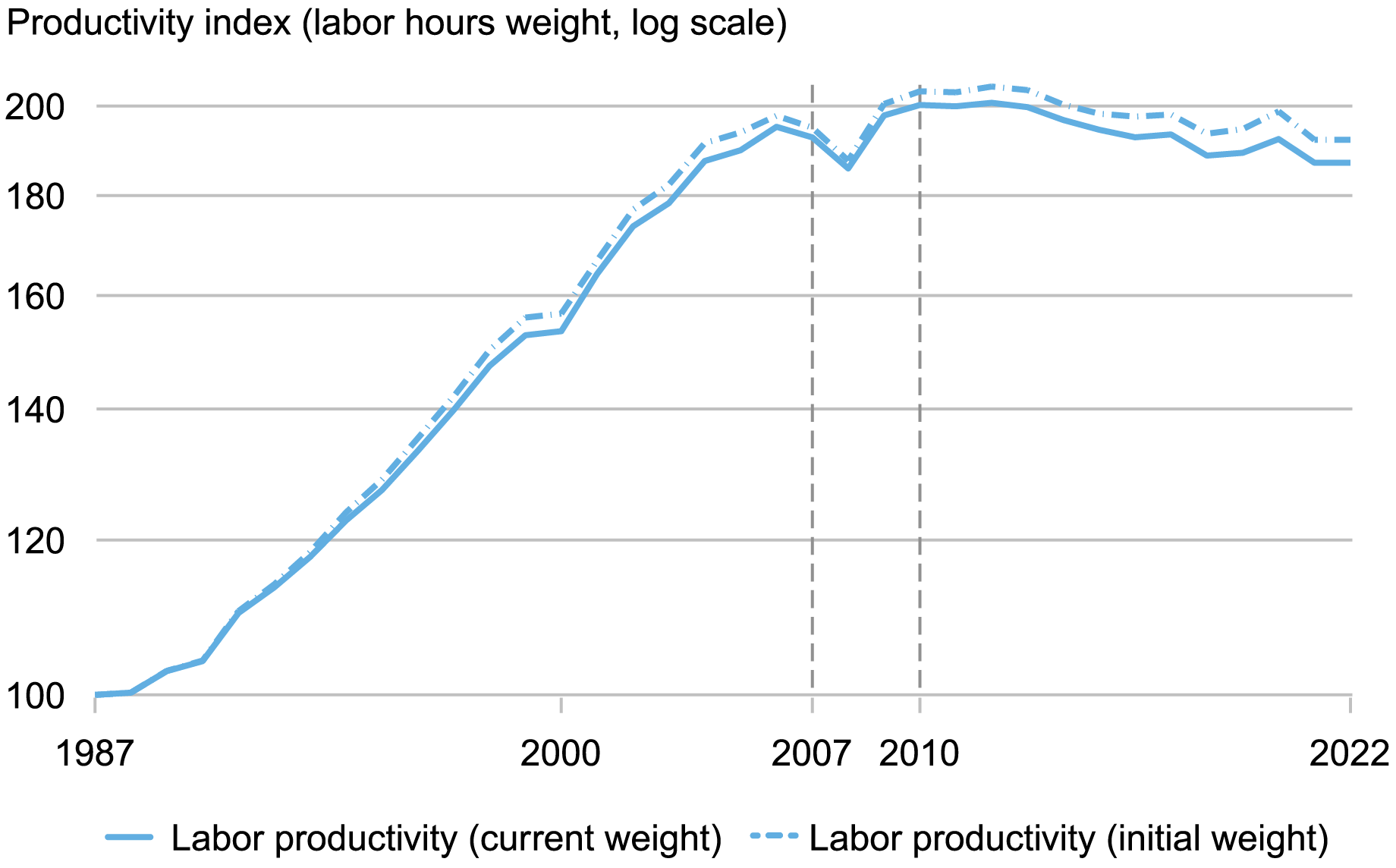
Notes: This chart exhibits the combination labor productiveness index from the BLS. It calculates the expansion in every {industry} labeled on the NAICS three-digit degree and computes the combination productiveness index by way of the share of every {industry} in whole employment in manufacturing, as outlined by labor hours. The preliminary values are normalized to be equal to 100 in 1987.
The stagnant productiveness because the late 2000s contrasts with the fast development over the previous decade (late Nineteen Nineties and early 2000s), which was consultant of the sector’s historic expertise all through the late nineteenth and twentieth century. The change within the development fee is stark. Because the desk beneath exhibits, labor productiveness grew at a median of three.4 p.c per 12 months from 1987 to 2007, whereas measured development in labor productiveness was –0.5 p.c from 2010 to 2022, implying a slowdown of three.9 share factors per 12 months.
Various Measurement Approaches Present the Slowdown in Productiveness Progress
| Progress Measure | 1987-2007 Annual Progress | 2010-22 Annual Progress |
|---|---|---|
| Labor productiveness | 3.4% (3.3%) | -0.5% (-0.6%) |
| TFP | 1.4% (1.4%) | 0.1% (0.1%) |
| Labor productiveness of main industries | 6.5% (6.6%) | -0.6% (-0.7%) |
| Labor productiveness of following industries | 1.9% (1.7%) | -0.6% (-0.5%) |
| Income LP of public corporations | 3.5% (3.6%) | -1.3% (-1.2%) |
| Income LP of main public corporations | 3.7% (3.8%) | -0.5% (-0.4%) |
| Income LP of following public corporations | 2.6% (2.8%) | -1.3% (-1%) |
Supply: Authors’ calculations primarily based on the Compustat and Bureau of Labor Statistics (BLS) Productiveness Accounts.
Notes: LP and TFP stand for labor productiveness and whole issue productiveness, respectively. The expansion charges contained in the parentheses report the values if the {industry} shares are fastened at their preliminary values in 1987. The information underlying the primary 5 rows are calculated primarily based on the BLS productiveness accounts and the info for public corporations comes from the Compustat knowledge set. Main industries are the highest 4 industries by way of their common labor productiveness development within the 1987-2007 interval, and the next industries are the rest of the industries. The main public corporations are the highest 4 corporations in every {industry} yearly primarily based on their common share of Compustat {industry} employment within the two years over which the expansion fee is calculated. The numbers in parentheses include the expansion fee fixing the preliminary {industry} shares in every case.
A pure first query is whether or not this slowdown stems from a gradual shift of manufacturing in the direction of underperforming manufacturing industries or the slowdown is going on inside every manufacturing {industry}. The chart beneath exhibits that the slowdown seems amongst each the fastest- and slowest-growing industries. Once we consider the 4 fastest-growing industries by way of labor productiveness from 1987 to 2007 (computer systems and electronics, textile mills, transportation gear, and electrical gear), these industries nonetheless exhibit a productiveness slowdown from 2010 to 2022, from 6.5 p.c within the pre interval to -0.6 p.c in the submit interval.
Productiveness Progress in Each Chief and Follower Industries Slows Down Starting within the Late 2000s
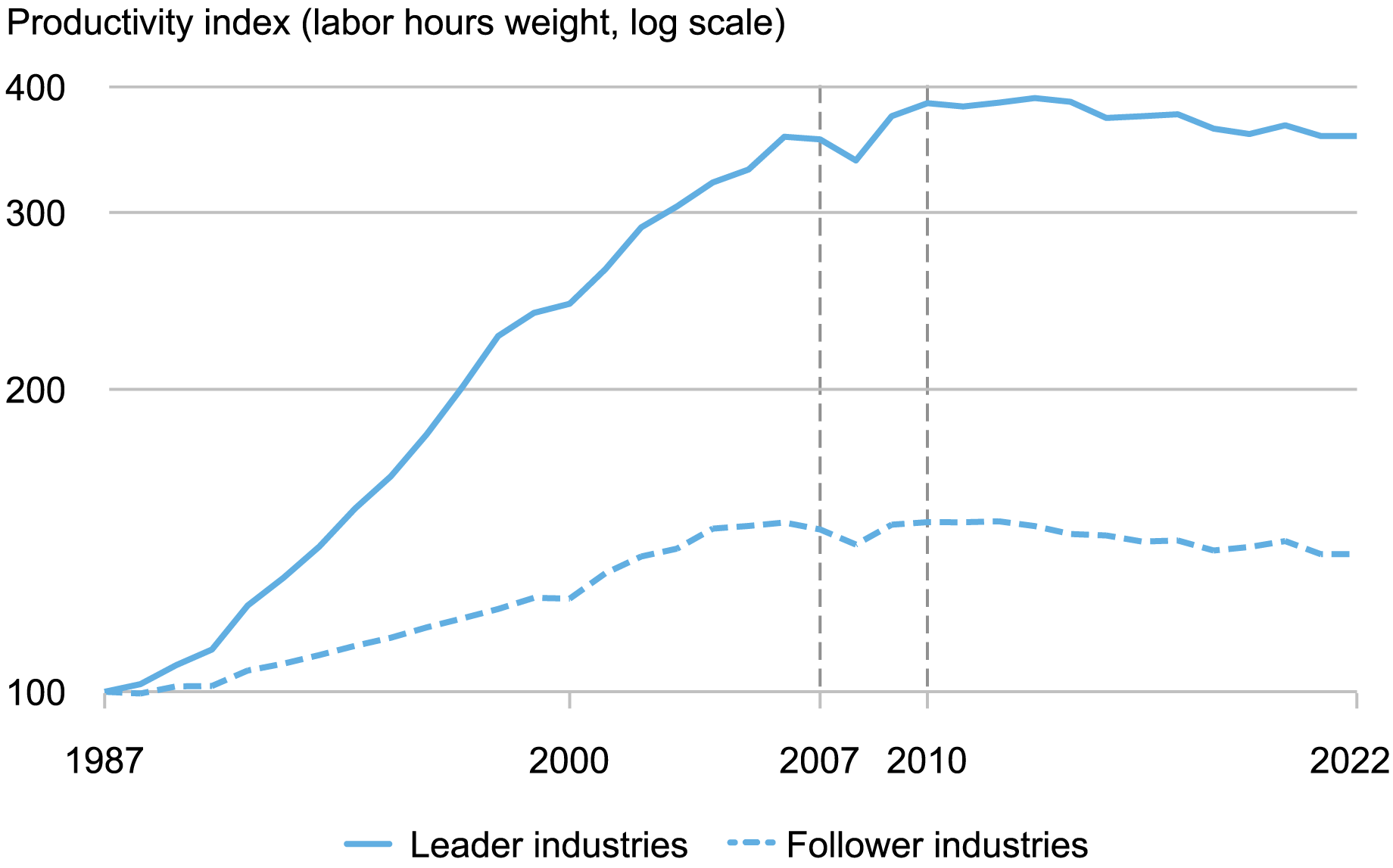
Notes: This chart exhibits the combination labor productiveness index from the Bureau of Labor Statistics (BLS) and splits by the 4 fastest-growing industries from 1987-2007 (“chief industries”) and the remaining (“follower industries”). It calculates the expansion in every {industry} on the NAICS three-digit degree and computes the combination productiveness index inside every group by way of the share of every {industry} in whole employment in manufacturing, as outlined by labor hours. The preliminary values are normalized to be equal to 100 in 1987.
Thus, most manufacturing industries, even these exhibiting stellar productiveness positive aspects within the Nineteen Nineties, suffered a sustained productiveness slowdown after the Nice Recession. This truth is especially puzzling in gentle of the widespread adoption of automation equipment and robots (see, for instance, Acemoglu and Restrepo [2020], which one may anticipate results in an increase in labor productiveness.
Whole Issue Productiveness vs. Labor Productiveness
One of many main drivers of labor productiveness is the quantity of productive capital obtainable to every employed employee in every {industry}. Is the autumn in manufacturing labor productiveness a byproduct of doubtless weaker capital funding within the sector? To research this query, we look at the tendencies in manufacturing whole issue productiveness (TFP), which is a measure of labor productiveness past what will be accounted for by the amount and high quality of capital and high quality of labor. If the labor productiveness slowdown is barely pushed by weak capital investments, then TFP ought to nonetheless be rising.
The following chart exhibits the tendencies in manufacturing TFP over the identical interval (1987-2022). Evaluating the 2 charts, we nonetheless discover a stark distinction between the noticed charges of development in TFP earlier than and after the Nice Recession. The common annual development of TFP falls from 1.4 p.c from 1987-2007 to 0.1 p.c from 2010-22. With each labor productiveness and TFP exhibiting important declines within the industry-level knowledge, we flip to microdata on the firm-level to additional discover the character of this decline.
Whole Issue Productiveness Progress Additionally Slows Down Starting within the Late 2000s
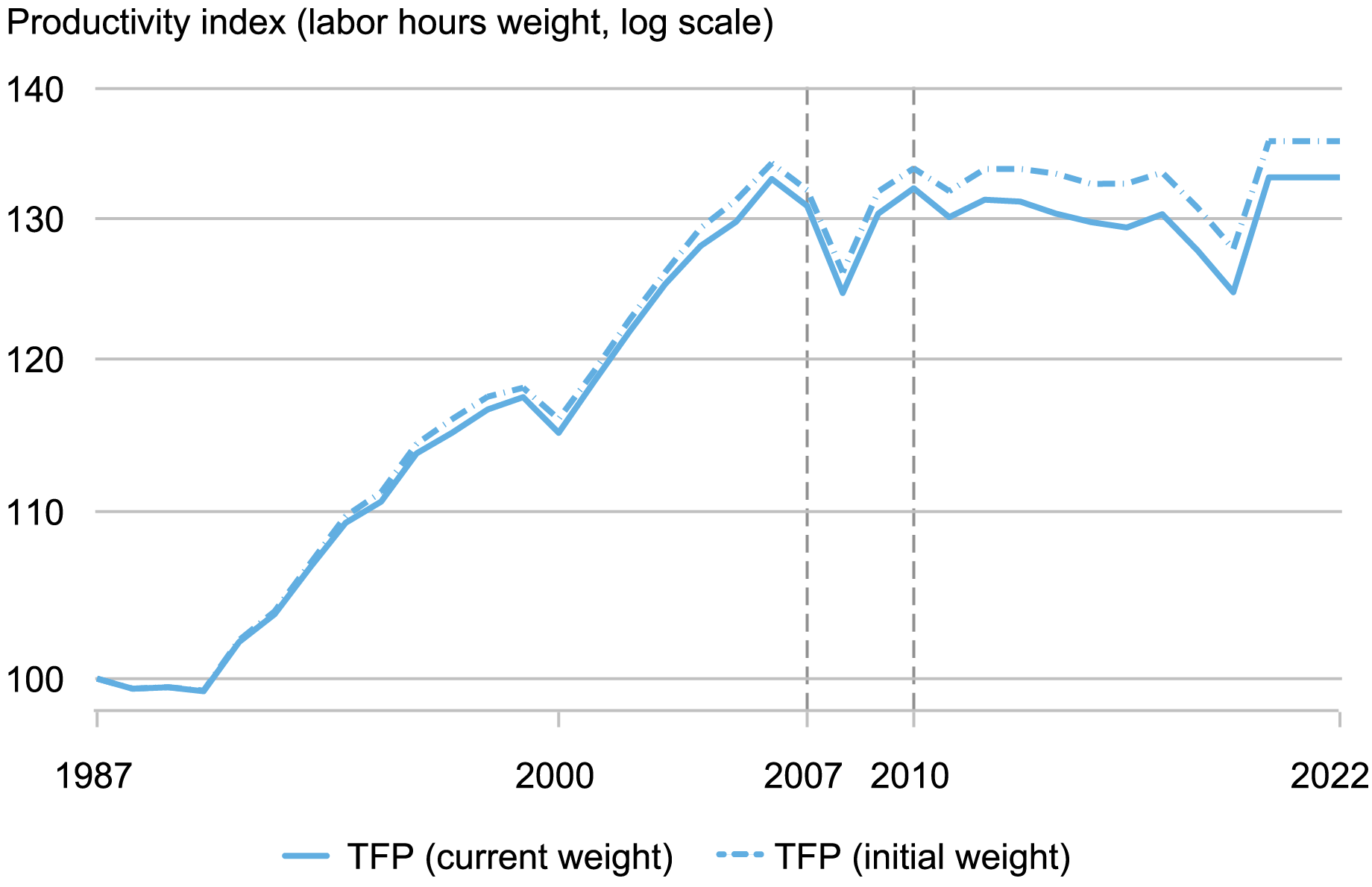
Notes: This chart exhibits the combination whole issue productiveness (TFP) index from the BLS. It calculates the TFP development in every {industry} labeled on the NAICS three-digit degree and computes the combination productiveness index by way of the share of every {industry} in whole employment in manufacturing, as outlined by labor hours. The preliminary values are normalized to be equal to 100 in 1987.
Productiveness Slowdown from a Agency-Stage Perspective
A number of of the reasons proposed for the productiveness slowdown level to an increase within the within-industry focus and the emergence of famous person corporations (Autor et al. 2020). For instance, one principle focuses on a productiveness hole between frontier corporations and most different corporations (as in, for instance, Klenow, Li, and Naff [2019] and Akcigit and Ates [2023]). The thought is that, whereas the main corporations proceed to innovate and develop in productiveness and dimension, most remaining corporations have fallen into productiveness stagnation. The hole between the main and laggard corporations finally undermines the incentives of the frontier corporations to proceed to maintain quick productiveness development, because the prospects of competitors from the opposite corporations fades because of their stagnation.
The following chart presents various measures of the labor productiveness of the U.S. manufacturing sector primarily based on the obtainable knowledge on the steadiness sheets of U.S. public corporations in manufacturing (the CRSP/Compustat knowledge set). Publicly owned corporations sometimes are usually bigger and extra productive than privately owned corporations.
Manufacturing Productiveness Slowdown Stems from Productiveness Slowdown on the Agency Stage
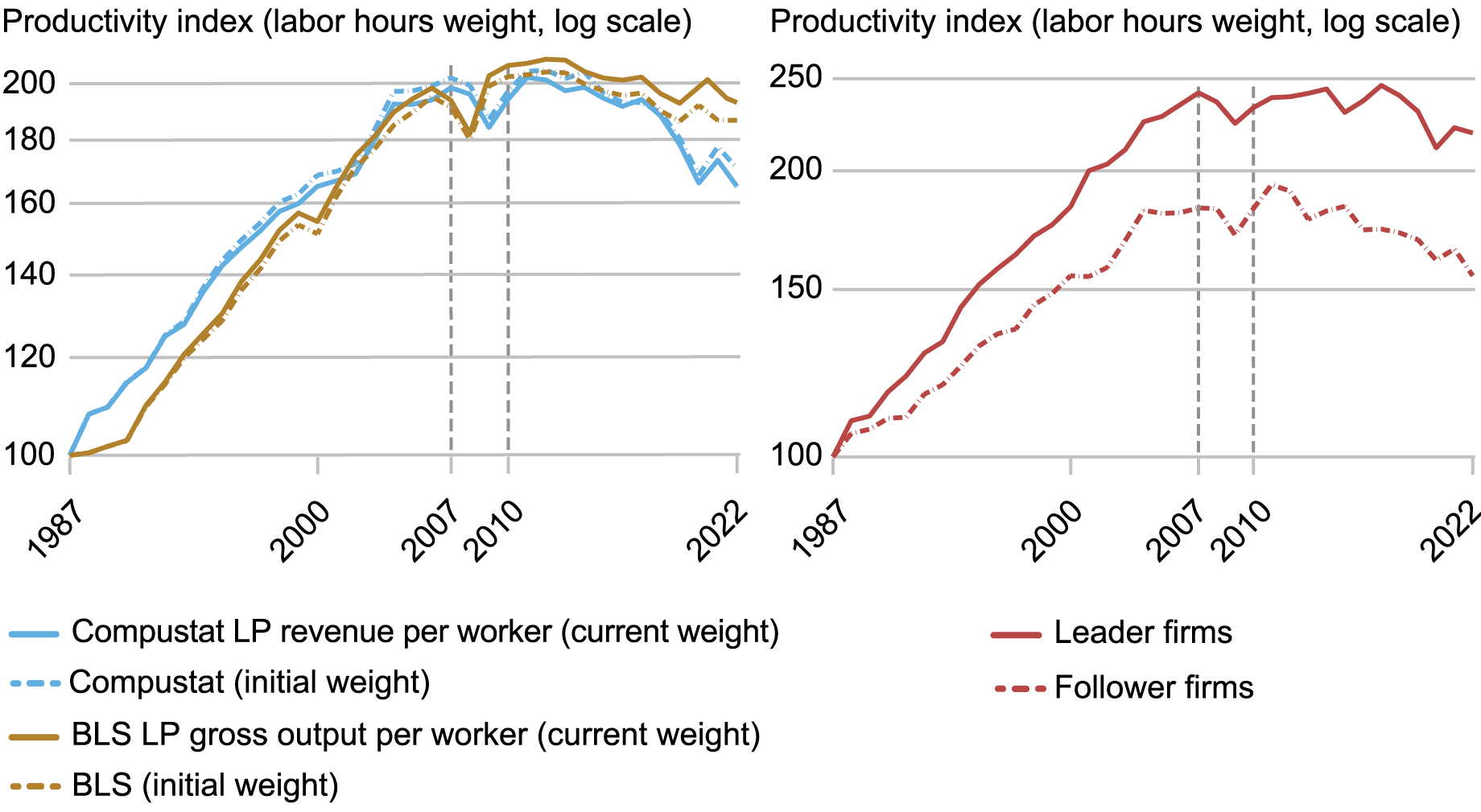
Notes: The left panel exhibits the revenue-labor productiveness of Compustat corporations in opposition to gross output labor productiveness measured from the BLS knowledge, following the identical process as earlier charts, with fastened and ranging {industry} shares with industries labeled on the NAICS three-digit degree. The correct panel performs the identical process and splits Compustat corporations into chief and follower corporations, as outlined by the highest 4 corporations in every NAICS3 class by way of common employment. The preliminary values are normalized to be equal to 100 in 1987.
To this point, we have now measured labor productiveness as worth added produced per hour labored. Nevertheless, within the Compustat knowledge, we solely observe firm-level output by way of income (a measure of gross output as an alternative of worth added) and firm-level labor inputs by way of the variety of employees. Within the left panel of the chart, we present the tendencies for manufacturing labor productiveness primarily based on gross output per employee within the official BLS knowledge set, which carefully mirror the these discovered utilizing worth added per hour. The left panel moreover exhibits the identical measure among the many public corporations within the {industry} noticed within the Compustat knowledge. We discover that the general public corporations exhibit the same slowdown in labor productiveness as seen within the aggregates from the BLS knowledge. From 1987 to 2007, the typical annual actual income development per employee averaged 3.5 p.c for corporations within the Compustat pattern, in step with the general change in labor productiveness. Within the 2010-22 interval, this measure of productiveness dropped to – 1.3 p.c.
The correct panel splits this pattern additional by trying on the 4 largest corporations in every {industry}, outlined by employment, and the remaining. Even throughout the main corporations in every {industry}, the patterns stay intact: a interval of quick development within the Nineteen Nineties and early 2000s is adopted by a interval of stagnation beginning within the mid-2000s. Related patterns emerge once we as an alternative use the highest two corporations or the very prime agency in every {industry} (not pictured).
Main corporations seem to have performed a bigger function within the productiveness growth within the Nineteen Nineties. For these corporations, the typical labor productiveness development within the 1987-2007 interval was 3.7 p.c, whereas follower corporations in Compustat skilled development of two.9 p.c in the identical interval. From 2010 to 2022, each main corporations and following corporations expertise related productiveness development declines. Main corporations present a median development fee of –0.5 p.c within the second interval, a 4.2 share level discount, whereas follower corporations expertise –1.3 p.c development, additionally a 4.2 share level discount. Thus, the productiveness slowdown seems to be a broad phenomenon affecting all industries and all corporations in every {industry}. These findings diverge from the latest findings within the literature that target massive corporations separating from smaller corporations (see, for instance, Andrews et al. [2015]). Whereas there may be proof of this separation, this seems to be largely coming from development within the Nineteen Nineties and early 2000s.
Summing Up
The slowdown in labor productiveness in manufacturing is among the most necessary long-run points in america that continues to be puzzling to economists and policymakers. This submit factors out that this improvement is widespread throughout industries and corporations, with even the fastest-growing industries and the biggest corporations experiencing the slowdown. It’s left to lecturers and policymakers to clear up the thriller about what elements are behind the ever present slowdown in productiveness.

Danial Lashkari is a analysis economist in Labor and Product Market Research within the Federal Reserve Financial institution of New York’s Analysis and Statistics Group.

Jeremy Pearce is a analysis economist in Labor and Product Market Research within the Federal Reserve Financial institution of New York’s Analysis and Statistics Group.
Easy methods to cite this submit:
Danial Lashkari and Jeremy Pearce, “The Mysterious Slowdown in U.S. Manufacturing Productiveness ,” Federal Reserve Financial institution of New York Liberty Avenue Economics, July 11, 2024, https://libertystreeteconomics.newyorkfed.org/2024/07/the-mysterious-slowdown-in-u-s-manufacturing-productivity/.
Disclaimer
The views expressed on this submit are these of the writer(s) and don’t essentially replicate the place of the Federal Reserve Financial institution of New York or the Federal Reserve System. Any errors or omissions are the accountability of the writer(s).


